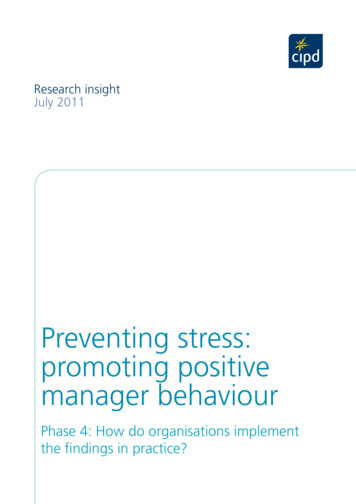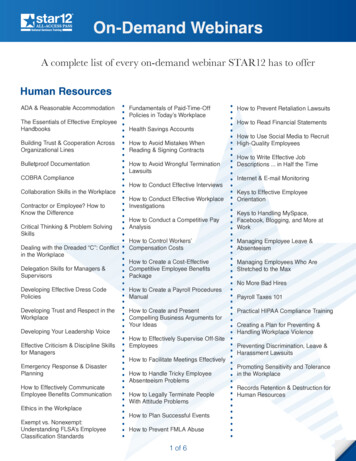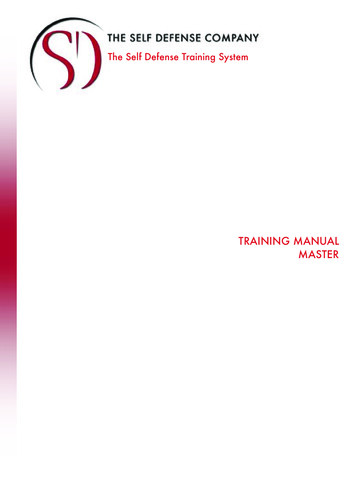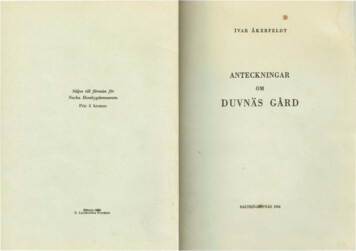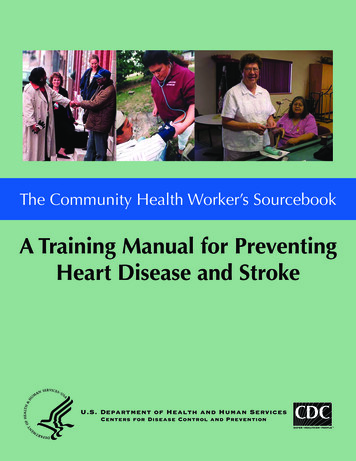
Transcription
The Community Health Worker’s SourcebookA Training Manual for PreventingHeart Disease and StrokeU.S. Department of Health and Human ServicesCenters for Disease Control and Prevention
Dear Community Health Workers and Trainers:Cardiovascular disease (CVD), which includes heart attack, stroke, heartfailure, and other conditions, is a main cause of death and disability in theUnited States. Every 45 seconds someone suffers a stroke, and every 3 to4 minutes a stroke kills someone. Every 26 seconds someone has a heartattack, and about every minute someone dies from one.There are many ways people can protect themselves from CVD. People canreduce their risk by making lifestyle changes, such as maintaining a healthyweight; being more physically active; eating more fruits and vegetables; eatingless salt, sugar, and animal fat; avoiding excessive intake of soft drinks andalcohol; and avoiding or stopping smoking.People can also reduce their risks by checking and keeping their bloodpressure and cholesterol under control; talking to and keeping appointmentswith their doctors and nurses; and taking their medicines as prescribed. If aCVD event occurs, people can increase their chance of survival and minimizethe damage by knowing the warning signs of heart attack, stroke, and heartfailure; knowing how to prepare for CVD emergencies; and understanding theimportance of calling 9-1-1 for help.The Community Health Worker’s Sourcebook: A Training Manual forPreventing Heart Disease and Stroke is a user-friendly curriculum thatcommunity health workers can use in their training and also as a resource.The sourcebook offers basic information and activities to increase skills inpreventing heart disease and stroke.Please use this sourcebook to lead others to healthier lives. You can make adifference.Sincerely,Darwin Labarthe, M.D., M.P.H., Ph.D.DirectorDivision for Heart Disease and Stroke PreventionNational Center for Chronic Disease Preventionand Health PromotionCenters for Disease Control and Prevention
About The Community Health Worker’sSourcebook: A Training Manual forPreventing Heart Disease and StrokeIn the United States, community health workers (CHWs) help us meet ournational Healthy People goals by conducting community-level activities andinterventions that promote health and prevent diseases and disability. CHWsare trusted, respected members of the community who serve as a bridgebetween their community members and professionals in the field of healthand human services. They provide an important service by establishing andimproving relationships between these professionals and members of thecommunity. As community health educators and role models, CHWs promote,encourage, and support positive, healthful self-management behaviors amongtheir peers. As community advocates, CHWs help people get the servicesand follow-up care they need. CHWs serve as patient and communityadvocates, as “coaches” for disease management, and as patient “navigators,”guiding patients through the health care system. They also strengthen theircommunity’s understanding and acceptance of medical care. The recognitionof their successes has led to recommendations that CHWs be included asmembers of health care teams to help eliminate racial and ethnic disparities inhealth care (see Appendix A: Resources at the end of this sourcebook).The sourcebook contains information and activities on heart disease andstroke and on the major risk factors for these diseases in adults. It alsocontains information on risk factors that begin in childhood. Additionally, itaddresses people’s adherence to treatment and their communication withhealth care providers. Because the sourcebook contains some technicalinformation, it is recommended for CHWs who already have someexperience in their profession. The sourcebook is not a replacementfor basic CHW training, which addresses core skills (See The NationalCommunity Health Advisor Study, Chapter 3: Core Roles and Competenciesof Community Health Advisors pp. 11–17; May 1998 University of Arizona,Tucson, Arizona, in Appendix A for more information). Examples of somebasic CHW training curricula are listed in Appendix A: Resources at theend of this sourcebook. Although the sourcebook does not address “patientnavigation,” Appendix A lists a link to a useful online toolkit that containsinformation on the topic; also, a future online version of this sourcebook willprovide updated information on patient navigation.The sourcebook is a resource that builds on strong partnerships betweenthe National Center for Chronic Disease Prevention and Promotion at theCenters for Disease Control and Prevention (CDC) and other agencies andorganizations. The material in the sourcebook has been adapted from TheThe Community Health Worker’s Sourcebooki
Women’s Wellness Sourcebook: Module III: Heart Disease and Stroke wasdeveloped for CHWs by the International Medical Services for Health, aninternational nonprofit organization. Staff within CDC have updated, reviewed,provided additional content, and pilot-tested the sourcebook. They have doneso in partnership with the University of Alabama at Birmingham ResearchPrevention Center; the American Heart Association; the American StrokeAssociation; the National Heart, Lung, and Blood Institute (NHLBI); the IndianHealth Service (IHS); the National Institute for Neurological Diseases; and theOak Ridge Institute for Science and Education. The sourcebook reflects thelatest research and national guidelines on heart disease and stroke and theirprevention.The sourcebook follows the familiar format of the well-known NHLBI trainingcurricula Your Heart, Your Life: A Lay Health Educator’s Manual (www.nhlbi.nih.gov/health/prof/heart/latino/eng mnl.pdf) and Honoring the Gift of HeartHealth: A Heart Health Educator’s Manual for American Indians and AlaskaNatives (www.nhlbi.nih.gov/health/prof/heart/other/aian manual/index.htm).This format makes the sourcebook a compatible training companion for thosefamiliar with the NHLBI training manuals.The sourcebook references the Web sites and products of other federalagencies and of private or not-for-profit organizations. A reference in thesourcebook to a specific Web site, commercial product, process, service, orcompany does not constitute its endorsement or recommendation by the U.S.government or by CDC.We thank you for your interest in this new resource. We welcome feedbackon your experiences in putting it to use. We are producing a limited numberof hard copies of the sourcebook, but we plan to make English and Spanishlanguage versions available on CDC’s Heart Disease and Stroke Web site in thenear future. Please send your comments on this sourcebook to:J. Nell Brownstein, Ph.D.Division for Heart Disease and Stroke PreventionNational Center for Chronic Disease Prevention and Health PromotionCenters for Disease Control and Prevention4770 Buford Highway NE, MS K47Atlanta, GA 30341-3717jnb1@cdc.govVisit our Web site at www.cdc.gov/dhdsp.ii
AcknowledgmentsThe development of The Community Health Worker’s Sourcebook: A TrainingManual for Preventing Heart Disease and Stroke would not have been possiblewithout the guidance and input of many persons who are committed to a hearthealthy and stroke-free world for all peoples. The Centers for Disease Controland Prevention (CDC) gratefully acknowledges their contributions.We thank the staff at CDC’s National Center for Chronic Disease Preventionand Health Promotion who provided content, review, and valuable feedback:Division of Heart Disease and Stroke Prevention:Carma Ayala, Ph.D.Nell Brownstein, Ph.D.Janet Croft, Ph.D.Shifan Dai, Ph.D.Sarah Yoon, Ph.D., R.N.Zhi Jie Zheng, Ph.D.Chris Stockmyer, M.P.H., R.D.Deborah Borbley, M.S., C.H.E.S., Office on Smoking and HealthJacqueline N. Epping, M.Ed., Division of Nutrition and Physical ActivitySarah Martin, Ph.D., Division of Nutrition and Physical ActivityDawn Satterfield, Ph.D., Division of Diabetes TranslationErica Odom, M.P.H., Division of Adolescent and School HealthMary Vernon-Smiley, M.D., M.P.H., Division of Adolescent and School HealthLinda Crossett, R.D.H., Division of Adolescent and School HealthWe extend special thanks to Darwin Labarthe, M.D., M.P.H., Ph.D., Director,and Kurt Greenlund, Ph.D., Associate Director for Science, Division for HeartDisease and Stroke Prevention, who reviewed the sourcebook in its entirety.Sincere thanks go to partners who pilot-tested an earlier version of thesourcebook:Carol Cornell, Ph.D., University of Arkansas for Medical SciencesMelissa Kuhajda, Ph.D., University of Alabama School of Medicine,TuscaloosaBonnie Sanderson, Ph.D., University of Alabama, BirminghamStaff at the Pine Apple Rural Health Clinic in Pine Apple, AlabamaCommunity Health Workers Ethel Johnson, Hattie Oates, Annie Aaron,and Jacqueline HivesWe are indebted to Sandra Dunbar, R.N., D.S.N., F.A.A.N., Nell HodgsonWoodruff School of Nursing, Emory University, for her review of the heartdisease chapters.iii
We appreciate the efforts of the staff of Grady Health System and the R.L.Brown Jr. Grady Medical Center at Hartsfield-Jackson Atlanta InternationalAirport in pilot-testing the sourcebook:Selma Morris, M.Ed.Gladys Long, CHWDani Howard, CHWMelissa Luck, CHWWe also thank the reviewers:Matilde Alvarado, R.N., M.S.N.Center for the Application of Research DiscoveriesNational Heart, Lung, and Blood InstituteJennifer Blackledge, M.S.W.Center for Senior Hypertension, Palmetto Health, South CarolinaLee Bone, M.P.H., B.S.N.Johns Hopkins Bloomberg School of Public Health, MarylandKaren P. Burton, Ph.D.Scientific Consultant, American Heart AssociationNancy J. HaaseBiostatistics Program Coordinator, American Heart AssociationMelissa Kuhajda, Ph.D.Institute for Rural Health Research, University of Alabama School ofMedicine, AlabamaRachael Tracy, M.P.H., C.H.E.S.Center for the Application of Research DiscoveriesNational Heart, Lung, and Blood Institute, National Institutes of HealthGayle Whitman, R.N., Ph.D., F.A.A.N., F.A.H.A.American Heart AssociationAnne Willaert, L.S.W.Healthcare Education Industry Partnership, Minnesota State Collegesand Universities, Minnesotaiv
We want to thank our partners for their guidance and feedback on thesourcebook and for the use of their resources:American Heart Association: Mark Schoeberl, M.P.H.Indian Health Service: James Galloway, M.D., F.A.C.P., F.A.C.C.National Heart, Lung, and Blood Institute: Robinson Fulwood, Ph.D., M.S.P.H.National Institute of Neurological Disorders and Stroke: Paul Scott, Ph.D.We owe the staff at International Medical Services for Health (INMED) specialrecognition for their willingness to let us adapt their original publication TheWomen’s Wellness Sourcebook: Module III: Heart Disease and Stroke.We wish to acknowledge our appreciation for community health workerseverywhere for their dedication to improving the health and well-being of theirfellow community memberThis document was prepared for the Centers for Disease Control and Prevention by the Oak RidgeInstitute for Science and Education (ORISE) through an interagency agreement with the U.S.Department of Energy (DOE). ORISE is managed by Oak Ridge Associated Universities under DOEcontract number DE-AC05-00OR22750.v
OverviewCommunity health workers (CHWs) can play a critical role in promotinghealthy living by educating community members about heart disease andstroke prevention and by helping people understand the importance of healthcare self-management, especially in underserved communities throughout theUnited States.The Community Health Worker’s Sourcebook: A Training Manual forPreventing Heart Disease and Stroke serves two purposes: 1) as aninstruction manual for training CHWs and 2) as a reference and a resourcefor CHWs working with community members. The sourcebook may be usedas an instruction manual by college instructors, health educators, nurses, andother health care professionals at health departments, community clinics,community colleges, and other organizations and agencies.Experienced CHWs should be included as part of the training team. However,the sourcebook is not intended as a train-the-trainer manual for CHWs touse with people in the community (as are the curricula Your Heart, Your Life:A Lay Health Educator’s Manual and Honoring the Gift of Heart Health: AHeart Health Educator’s Manual for American Indians and Alaska Natives)because the sourcebook chapters are too detailed. In addition to providingguidance to trainers, the sourcebook is meant to serve as a reference and aresource 1) for CHWs working with community members in preventing heartdisease and stroke and 2) for CHWs working with those who already haveheart disease, or who have already had a heart attack or stroke. In our pilottraining using this sourcebook, we found that the CHWs wanted access to theentire sourcebook during the training. The sourcebook contains a variety ofhandouts, which are appropriate for CHWs to use as tip sheets and to give tocommunity members as aids for understanding and living with heart diseaseand stroke disability.After completing the sourcebook, CHWs should— Have a basic understanding of how the heart and blood vessels work.Know risk factors for and causes of heart disease and stroke.Know the warning signs of heart attack and stroke.Know the signs of heart disease and other conditions that can lead toheart attack and stroke. Know the most common treatments for diseases of the heart and bloodvessels, for heart attack and stroke, and for contributing conditions,such as high blood pressure, high blood cholesterol, and diabetes. Know how they can help people in the community who are living withheart disease or a stroke-related disability take care of themselves,and prevent a second heart attack or a second stroke.vii
Be able to work with communities and community members to preventheart disease and stroke by encouraging healthy eating, physicalactivity, tobacco control, and stress reduction at the individual, family,and community level. Be able to show people how to take greater control over their health.Trainers working with CHWs can teach the sessions (chapters) in thesourcebook from beginning to end, or they can teach individual lessons asneeded. The first chapter is an overview. It is followed by chapters on stroke,heart attack, and two related cardiovascular diseases—heart failure and atrialfibrillation (Chapters 2 to 5). The next four chapters (Chapter 6 to 9) coverrelated physical and mental health issues, most of which are risk factors forheart disease and stroke: depression and stress, high blood pressure, highblood cholesterol, and diabetes. The following two chapters (Chapters 10and 11) focus on talking to your doctor and taking medicine. Four chapters(Chapters 12 to 15) provide information on lifestyle behaviors that cansignificantly reduce the risk for heart disease and stroke or can reduce thechances for a second heart attack or stroke. These chapters discuss healthyeating and weight control, physical activity, and tobacco control. The finalchapter (Chapter 16) addresses preventing heart disease by encouraginghealthy lifestyle behaviors in children and teens. Appendix A contains selectedresources for the trainer and the CHWs to use. Finally, Appendix B containsmedicine charts that the trainer may or may not choose to use or provide tothe CHWs.Note to trainer: Two commonly used terms found throughout the sourcebookare diagnose and prescribe. You may want to define these terms, in lay terms,for the CHWs.Diagnose means to identify or find the cause of an illness or disorder in apatient through a physical exam, an interview, and medical tests.Prescribe means to recommend a good medicine to help a patient.viii
How to Use the SourcebookEach of the chapters is designed to be a learning session. Each of the 15chapters in the sourcebook contains— An overview—an introduction to the topic and why it is important. A lesson—what CHWs should know about the topic. A summary—a review of the key points.The format of the instruction for the 15 sessions is conversational. Thesessions are intended to be taught in an informal manner with as much inputfrom, and interaction with, the CHWs as possible using principles of adult andpopular education.Instructors should explain at the beginning of the course that the instruction isinformal and that questions and comments are encouraged. If the CHWs arereluctant to speak out, the instructor should look for visual cues (for example,questioning or puzzled looks) that signal the need to stop and ask if anyonehas a question.The lesson in each chapter provides an opportunity for active discussion byintroducing a handout to be reviewed and discussed, a group activity, or a structured group discussion. Each opportunity for interaction is identified by a symbol.HandoutActivityDiscussionOverheads and slides are not provided, but pictures that promoteunderstanding of the topics are provided in the handouts. Instructors shouldprovide their own visual aids if they believe that more graphics are needed torepresent their communities.Excellent sources for visual aids, and for culturally appropriate activities forCHWs to do with community members, to promote heart-healthy and strokefree living, are the educational materials available from the National Heart,Lung, and Blood Institute (NHLBI), especially the training manuals Your Heart,Your Life: A Lay Educator’s Manual (www.nhlbi.nih.gov/health/prof/heart/latino/eng mnl.pdf), and Honoring the Gift of Heart Health: A Heart HealthEducator’s Manual for American Indians and Alaska Natives (www.nhlbi.nih.gov/health/prof/heart/other/aian manual/index.htm).Also, check Appendix A for sources of other educational materials.ix
Before Beginning the Training SessionsInstructors should read through the entire sourcebook. As they review it, theyshould consider the following suggestions for enhancing the curriculum andinvolving other community providers in the education of CHWs. If the trainerdoes not already work with the organizations or persons mentioned below,he or she may need as long as six months to establish partnerships beforebeginning the training course. Arrange for CHWs to get professional training on taking blood pressureand pulse measurements if they are not able to get this trainingthemselves. Arrange for CHWs to get training in CPR (cardiopulmonaryresuscitation) and in the use of an AED (automated externaldefibrillator). Arrange, if possible, for CHWs to visit stroke and cardiac rehabilitationcenters and hospital emergency departments to view the equipmentused for stroke and heart attack patients and to meet staff. Perhaps thestaff could review the tests and equipment used and answer questionson site. Invite emergency medical technicians (EMTs) to class, or take theclass members to an EMS (emergency medical services) trainingcenter to learn more about signs of heart attack, heart failure, andstroke; the importance of calling 9-1-1; and what is done duringtransport to the hospital in order to keep people alive. Invite a pharmacist to the class so that students can learn tips formedicine management and ask questions. Perhaps the pharmacistcould review the “Medicine” handouts (located in the Appendix B). Teach or arrange for CHWs to learn stress-reduction techniques, suchas deep breathing and visual imagery. Invite local staff to the class, or arrange for the class members to visitlocal human resources and medical agencies to learn how to bridgethe gaps in basic living and medical needs in order to support patientself-management.x
We recommend that trainers also research local community resourcesand prepare a resource manual for the CHWs. There may alreadybe community resource handouts to which information could beadded (for example, caregiver support group information; locations andtimes of free blood pressure screenings or measurements; locationsof hospitals designated as “stroke centers”; locations of the closesthospitals in the CHWs’ neighborhoods; and locations of clinics andother resources for getting free or low-cost medications, blood pressuremachines, bathroom scales, and other needed medical items).For the InstructorThe average instruction time for each session (each chapter) is approximately2½ hours. Some chapters, such as Chapter 10: Talking to Your Doctor andChapter 11: Taking Medicine, take less time to cover. Others, such as Chapter9: Diabetes and Chapter 12: Healthy Eating and Weight Control, may requiremore time. The length of time for each session will be determined mainly byhow involved the CHWs are in the discussions.Your Heart, Your Life: A Lay Health Educator’s Manual offers the following tipsfor instructors.BreaksYou should take a short break in the middle of each session. You may want touse the time to have participants do some easy stretches.RefreshmentsYou may want to serve a small, heart-healthy snack and a beverage duringthe break. Some ideas for heart-healthy snack foods are salsa with bakedunsalted tortilla chips, fruits or vegetables with low-fat dip, juices, and water.xi
Working with Your GroupLeading the Group Get to know the members of your group. They may have differentbackgrounds, interests, and needs. Use words and terms that are familiar to the people in your group.A banana is known as a plátano to some and as a guineo to others.Oranges may be called naranjas or chinas. Encourage the group to ask questions to- Help them see how the information applies to their lives as wellas their community work.- Help them remember what they learn. Occasionally summarize key points and concepts. Keep the sessions flowing smoothly so everyone stays interested andinvolved. Be ready to deal with people who talk too much. Thank the personfor sharing his or her opinion. Then quickly ask if anyone else hassomething to share. Help CHWs who do not read or write well in a way that will not bringattention to them.- Offer help. Do not force anyone to accept help.- Change the activity to a group discussion. Watch for clues from CHWs who do not understand; such as,- Puzzled looks- Wrinkled foreheads- Looking away from you(Try to present the information in a different way if you see these signs.)Motivating Group Members To keep CHWs motivated, praise or reward their efforts.- Give praise when it is deserved. Doing so gives the praise moremeaning.- Praise people in front of others. Doing so can help them staycommitted. Encourage the CHWs to share their opinions.- Show interest in the members and what they have to say.- Be patient. Some people may not speak because they havenever been asked to share their opinions in a group setting.- Try to involve everyone in the discussion and activities, but donot force anyone to speak. People will speak up when theybecome used to the group.xiiThe Community Health Worker’s Sourcebook
Taking Small Steps toward Change Tell the CHWs that people are more likely to develop new habits if youpromote small changes, slowly. This approach takes patience but oftenbrings success. Relate new concepts in the lessons to the CHWs’ work and personallives. Provide opportunities for the CHWs to practice new skills.Getting People to Come to the SessionsRemind the CHWs that it is important to come to all the sessions. Tell themthat they will— Learn something new at each session. Help community members. Socialize and meet people.Answering Hard QuestionsRemember that it’s okay not to know all the answers! Tell the group that youwill have the correct answer after the break or by the next training session.Call a local health educator, nutritionist, nurse, or doctor to find the answer.Keeping People on TrackIf a CHW gives incorrect or incomplete information during a session, providethe group with the correct information. Give the CHW credit for any part of hisor her answer that is correct. Tell the group that people often hear incorrectinformation and believe it to be fact. Tell the CHWs that one important reasonwhy they are taking the course is to get correct information.And finally Have a good time. You are doing an important service for your community.The Community Health Worker’s Sourcebookxiii
What Community Health Workers Can DoThroughout the sourcebook chapters you will find lists of helpful suggestionsabout what Community Health Workers can do (with program support) to helpcommunity members prevent heart disease and stroke. We encourage you totake the time to have the CHWs talk about and share these and many otherthings they do to help community members. The following is a list of generaltips and practices that CHWs can use to help community members improvetheir health and support people in their access to health care.Supporting People in Their Health Care Needs: Remind community members to get screened for high bloodpressure, high blood cholesterol, and for high blood glucose. Remind community members to regularly check their blood pressure. Tell them about places in community (fire stations, communitycenters, drug stores) where they can get blood pressure checkedfree. Help people make and keep appointments and follow-up visits withtheir doctors. Help community members who do not speak English. Help those who do not have a doctor, find a doctor. Help those who cannot afford a doctor find free health care or placeswhere cost is based on ability to pay (for example, public healthdepartments, clinics run by churches, community clinics). Help community members who do not have transportation, or do notknow how to use public transportation to get to the clinic. Be a bridge between the stroke survivor and the healthcare team(doctors, nurses, pharmacists, etc.). Tell the health care team about specific patient needs, successes,and barriers to self-care (for example, cultural beliefs, motivation,disability, safety issues).Helping People Make Better Lifestyle Choices: Help people choose a diet with plenty of vegetables, fruits, andgrain products. Encourage people to eat foods rich in minerals andvitamins such as citrus fruits, tomatoes, bananas, grains, leafy greenvegetables, and navy, pinto, and kidney beans. Help people choose a diet low in fat, saturated fat, trans fat, andcholesterol. Encourage people to eat less fatty food and to decrease the foodsthey fry. Help community members learn how to reduce their intake of salt andsodium.xivThe Community Health Worker’s Sourcebook
Get the family involved in making healthy choices about eating—athome and away from home. When making home visits look for clues that the family may need tipsfor eating healthier food (for example, lots of snack foods, sodas, orhigh-fat items in the house). Encourage people to limit alcohol intake to no more than one(women) or two (men) drinks a day. One drink is 1 oz. of hard liquor, 4oz. of wine, or 12 oz. of beer Work with community members to find ways to make low-costfruits and vegetables and low-salt and low-fat foods available in thecommunity, schools, and work sites. Encourage people to be more active. Get the family involved in making healthy choices about being active. Work with community leaders to find safe places for people to walk,as well as other physical activity resources in the community and inworksites. CHWs can start and lead walking groups. Encourage overweight people to lose weight. Encourage people to quit smoking.Cultural ActivitiesIn a course for CHWs who work with community members in areas thatheavily use more traditional forms of medical care, and where healthcare practices and traditions differ from ”Western medicine,” an activitythat provides the opportunity for CHWs to talk about problems they mightencounter as a result of differences in cultures and traditions could be helpful.Include a Cultural Activity in Each SessionLet the CHWs talk about the barriers in their community and how they can getcommunity members to follow the advice given in each session.Following is one example of a cultural activity on heart attack.The Community Health Worker’s Sourcebookxv
Discussion: Preventing Heart Attacks in Your CommunityAsk the CHWs to name some of the problems or barriers theythink they will encounter when promoting heart disease and strokeprevention. Then ask the CHWs to think of ways to overcome thesebarriers.Using a flipchart, draw a line down the middle of the paper. Write theproblems that CHWs identify on the left and the ways to overcomethese problems on the right. Say:What do your community members feel is the cause of heart attacksand stroke?What is the best way to inform them of the risk factors for heart attackand the healthy lifestyle behaviors that you have just learned?Some questions to ask the CHWs might be— What type of problems might you encounter when teachingWestern medicine to elders in the community? What are some beliefs that members of your community haveabout heart disease and stroke? How are heart attacks treated in your culture (or nativecountry)? Think of ways you can combine traditional treatments with thetreatments used by doctors. Say:Now that you know about the risk factors and behaviors that mightlead to a heart attack, how can you help prevent heart attacks in yourcommunity?It might help to talk about some of the problems you could face. For example, could you face problems with older communitymembers not taking their medicine? Not trusting the doctor?Fearing tests that diagnose health problems? Could you face problems with men not going to the doctor? Notproviding the information the doctor needs and not answeringthe doctor’s questions truthfully? What might keep women from doing what they need to preventa heart attack? How might a member of your community react when learningthat he or she has had a heart attack or stroke?The Provider’s Gu
Preventing Heart Disease and Stroke is a user-friendly curriculum that . Resources at the end of this sourcebook). The sourcebook contains information and activities on heart disease and stroke and on the major risk factors for these diseases in adults. It also contains information on risk factors that begin in childhood. Additionally, it



